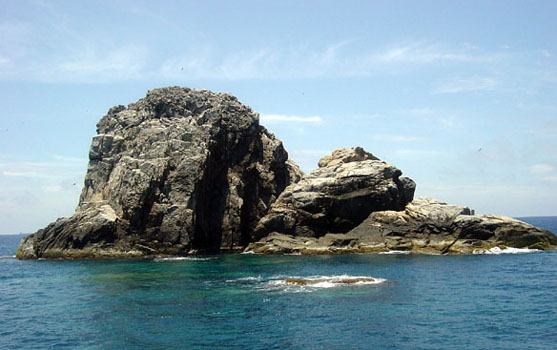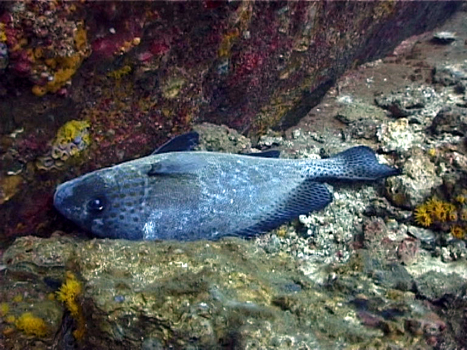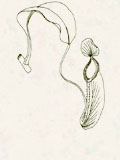
Vertebrates (pdf)
Fishing carnage at Pedro Blanco
by Charles Frew and Andy Cornish
Fish populations at Pedro Blanco ( ¤j«C°w ), an isolated rock pinnacle lying 85 kilometers due east of Hong Kong in mainland Chinese waters are being devastated (Fig. 1). Fishers using explosives have been increasingly targeting the once healthy fish stocks, while at weekends hoards of spearfishers from Hong Kong descend to pursue those fishes remaining. It wasn't always like this. Just five years ago, when we first visited the site, the diving was some of the best we had experienced anywhere in SE Asia with large schools of Kawakawa tuna (Euthynnus affinis) (Fig. 2), Pickhandle barracuda (Sphyraena jello), and abundant groupers, parrotfishes and other reef fishes rarely seen in Hong Kong waters. Large oceanic fishes such as Whale shark (Rhincodon typus), Yellowfin tuna (Thunnus albacares) and Manta ray (Manta sp.) have also been seen in recent years.
 |
| Fig. 1. Pedro Blanco |
Light fishing pressure was one likely reason why fish populations were so diverse compared with Hong Kong, but it also seems possible that different larval sources have played a part. Although it is often quoted that the branch of the tropical Kuroshio current that passes through the Luzon Strait approaches Hong Kong (e.g. Morton and Morton, 1983), it has been difficult to establish whether it actually reaches Hong Kong waters (Tang and Ni, 1996). The presence of tropical species common at Pedro Blanco and known from the Philippines (www.fishbase.org) but not from Hong Kong waters (Sadovy & Cornish, 2000) suggests fish larvae are transported to this pinnacle from the east by the Kuroshio current, but that this water body does not often get close enough to coastal reefs to allow larval settlement. Such species include Tropical striped triplefin (Helcogramma striatum), Yellow-brown wrasse (Thalassoma lutescens) and Reticulated sandperch (Parapercis tetracantha) (Fig. 3).
 |
| Fig. 2. Kawakawa (Euthynnus affinis) |
The isolation that once protected the fishes at Pedro Blanco now seems to be working against them. A letter written to the Guangdong Marine Fisheries and Agricultural Bureau in 2003 informing them of the blast fishing situation met with a favourable response and seems to have resulted in increased patrols in 2004. However, bombing continues as the rock is too isolated for regular patrols and it is difficult to catch the bombers in the act (Fig. 4). In addition, the increase in popularity of recreational fishing and spearfishing in Hong Kong in recent years, and the introduction of larger dive boats capable of taking up to 40+ divers to the site have greatly increased fishing pressure from these gears. As in Hong Kong, such fishing is not regulated.
 |
| Fig. 3. Reticulated sandperch (Parapercis tetrtacantha) |
Although the effect of recreational fishers is probably fairly low, so many spearfishers targeting large reef fishes that typically show long life and are slow to reach sexual maturation is likely having a devastating effect on the fish populations on such a small reef. Even this, however, pales with comparison to the destruction from blast fishing. Blast fishing kills indiscriminately large and small fish alike through rupturing of swim bladders and spinal columns, and the bombs being used recently are large enough to be fracturing the bedrock. Hundreds of fishes have been seen lying on the seabed following bombing as they sink to the bottom and the fishers only collect those few floating on the surface (Fig. 5). On a recent dive trip to Pedro Blanco, no groupers were encountered and only small schools of E. affinis were present. Unicorn leatherjacket (Aluterus monoceros), Hound needlefish (Tylosurus crocodilus crocodilus) and countless moray eels lay on the seabed, evidence of recent bombing. As a final insult, divers from a Hong Kong dive centre were using small spears to jab into small holes and damaging surrounding corals.
 |
| Fig. 4. Bomb blast |
So what is the solution? Pedro Blanco is an ideal site for some kind of Marine Protected Area in terms of its rich marine life, but enforcing regulations would be problematic due to the large distance between the pinnacle and mainland ports. For the time being we would like to see an increased effort by the mainland authorities to tackle the blast fishing problem, a realization by recreational and spear-fishers from Hong Kong that the fish populations at the pinnacle are limited, and that restraint needs to be shown in terms of the numbers of fishes and size taken if this amazing site is not to be ruined for everyone.
 |
| Fig. 5. Blasted Painted sweetlips (Diagramma pictum) |
Bibliography
Morton B. & Morton J. (1983). The sea-shore ecology of Hong Kong. Hong Kong University Press, Hong Kong. pp 350.
Sadovy Y. & Cornish A.S. (2000). Reef Fishes of Hong Kong. Hong Kong University Press, Hong Kong. pp 321.
Tang, D. & Ni, I.H. (1996). Remote sensing of Hong Kong waters: Spatial and temporal changes of sea surface temperature. Acta Oceanographica Taiwanica. 35(2): 173-186.
|
|
P.6-8 |
|
Porcupine! |
 Copyright © 2000 |
